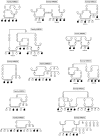Homozygosity mapping in 64 Syrian consanguineous families with non-specific intellectual disability reveals 11 novel loci and high heterogeneity
- PMID: 21629298
- PMCID: PMC3198153
- DOI: 10.1038/ejhg.2011.98
Homozygosity mapping in 64 Syrian consanguineous families with non-specific intellectual disability reveals 11 novel loci and high heterogeneity
Abstract
Non-specific intellectual disability of autosomal recessive inheritance (NS-ARID) represents an important fraction of severe cognitive dysfunction disorders. To date, only 10 genes have been identified, and further 24 linked-ARID loci have been reported, as well as others with suggestive linkage. To discover novel genes causing NS-ARID, we undertook genome-wide homozygosity mapping in 64 consanguineous multiplex families of Syrian descent. A total of 11 families revealed unique, significantly linked loci at 4q26-4q28 (MRT17), 6q12-q15 (MRT18), 18p11 (MRT19), 16p12-q12 (MRT20), 11p15 (MRT21), 11p13-q14 (MRT23), 6p12 (MRT24), 12q13-q15 (MRT25), 14q11-q12 (MRT26), 15q23-q26 (MRT27), and 6q26-q27 (MRT28), respectively. Loci ranged between 1.2 and 45.6 Mb in length. One family showed linkage to chromosome 8q24.3, and we identified a mutation in TRAPPC9. Our study further highlights the extreme heterogeneity of NS-ARID, and suggests that no major disease gene is to be expected, at least in this study group. Systematic analysis of large numbers of affected families, as presented here, will help discovering the genetic causes of ID.
Figures


References
-
- Ropers HH. Genetics of early onset cognitive impairment. Annu Rev Genomics Hum Genet. 2010;11:161–187. - PubMed
-
- Rauch A, Hoyer J, Guth S, et al. Diagnostic yield of various genetic approaches in patients with unexplained developmental delay or mental retardation. Am J Med Genet A. 2006;140:2063–2074. - PubMed
-
- Ropers HH, Hamel BC. X-linked mental retardation. Nat Rev Genet. 2005;6:46–57. - PubMed
-
- Bartley JA, Hall BD. Mental retardation and multiple congenital anomalies of unknown etiology: frequency of occurrence in similarly affected sibs of the proband. Birth Defects Orig Artic Ser. 1978;14:127–137. - PubMed
-
- Priest JH, Thuline HC, Laveck GD, Jarvis DB. An approach to genetic factors in mental retardation. Studies of families containing at least two siblings admitted to a state institution for the retarded. Am J Ment Defic. 1961;66:42–50. - PubMed
Publication types
MeSH terms
Substances
LinkOut - more resources
Full Text Sources
Molecular Biology Databases
Miscellaneous

